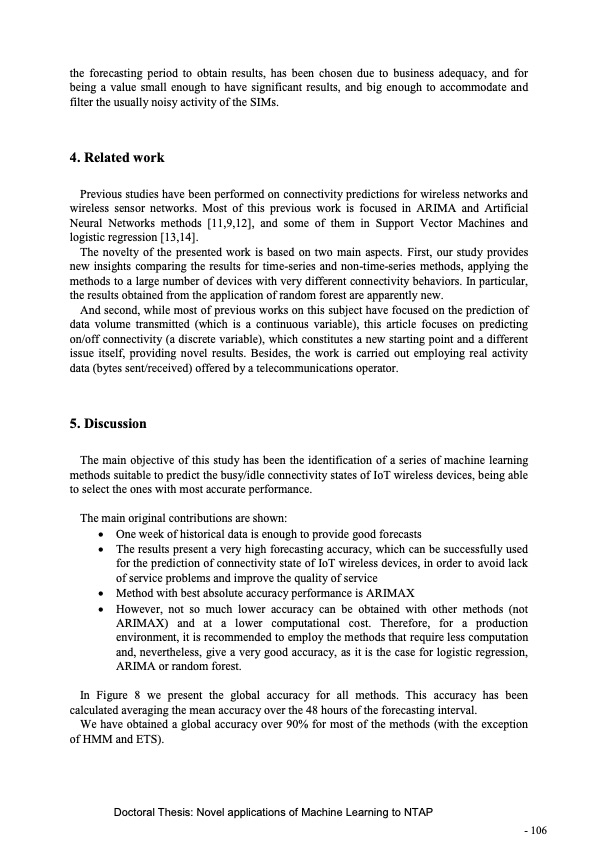
PDF Publication Title:
Text from PDF Page: 108
the forecasting period to obtain results, has been chosen due to business adequacy, and for being a value small enough to have significant results, and big enough to accommodate and filter the usually noisy activity of the SIMs. 4. Related work Previous studies have been performed on connectivity predictions for wireless networks and wireless sensor networks. Most of this previous work is focused in ARIMA and Artificial Neural Networks methods [11,9,12], and some of them in Support Vector Machines and logistic regression [13,14]. The novelty of the presented work is based on two main aspects. First, our study provides new insights comparing the results for time-series and non-time-series methods, applying the methods to a large number of devices with very different connectivity behaviors. In particular, the results obtained from the application of random forest are apparently new. And second, while most of previous works on this subject have focused on the prediction of data volume transmitted (which is a continuous variable), this article focuses on predicting on/off connectivity (a discrete variable), which constitutes a new starting point and a different issue itself, providing novel results. Besides, the work is carried out employing real activity data (bytes sent/received) offered by a telecommunications operator. 5. Discussion The main objective of this study has been the identification of a series of machine learning methods suitable to predict the busy/idle connectivity states of IoT wireless devices, being able to select the ones with most accurate performance. The main original contributions are shown: • One week of historical data is enough to provide good forecasts • The results present a very high forecasting accuracy, which can be successfully used for the prediction of connectivity state of IoT wireless devices, in order to avoid lack of service problems and improve the quality of service • Method with best absolute accuracy performance is ARIMAX • However, not so much lower accuracy can be obtained with other methods (not ARIMAX) and at a lower computational cost. Therefore, for a production environment, it is recommended to employ the methods that require less computation and, nevertheless, give a very good accuracy, as it is the case for logistic regression, ARIMA or random forest. In Figure 8 we present the global accuracy for all methods. This accuracy has been calculated averaging the mean accuracy over the 48 hours of the forecasting interval. We have obtained a global accuracy over 90% for most of the methods (with the exception of HMM and ETS). Doctoral Thesis: Novel applications of Machine Learning to NTAP - 106PDF Image | Novel applications of Machine Learning to Network Traffic Analysis

PDF Search Title:
Novel applications of Machine Learning to Network Traffic AnalysisOriginal File Name Searched:
456453_1175348.pdfDIY PDF Search: Google It | Yahoo | Bing
Cruise Ship Reviews | Luxury Resort | Jet | Yacht | and Travel Tech More Info
Cruising Review Topics and Articles More Info
Software based on Filemaker for the travel industry More Info
The Burgenstock Resort: Reviews on CruisingReview website... More Info
Resort Reviews: World Class resorts... More Info
The Riffelalp Resort: Reviews on CruisingReview website... More Info
| CONTACT TEL: 608-238-6001 Email: greg@cruisingreview.com | RSS | AMP |